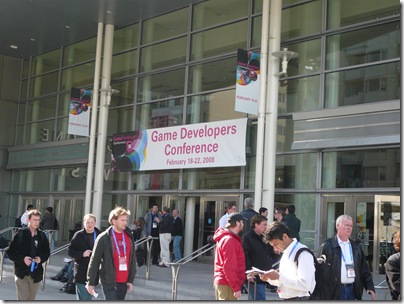GDC: Wednesday
Filed under 3D, Programming, Video Games
Optimizing DirectX Rendering on Multi-Core Hardware
I didn't get much out of this that I hadn't already heard before.
They presented some profiling for some games that showed 50% of CPU time was spent on graphics related tasks.
They gave a list of tools that are helpful for profiling:
- Intel's VTune Performance Analyzer
- Intel's Thread Profiler
- Microsoft's PIX for Windows
- AMD's CodeAnalyst
Some of the talk was about the benefit of multiple cores verses the overhead required to synchronize multiple cores.
Expo
Sandbox2 editor for CryENGINE by Crytek
- Best/slickest game editor I've ever seen
- An editor built on top of the game engine
- Everything is WYSIWYG
- Artists can get great results very quickly
- Realtime Shadows
- Realtime Ambient Occlusion
Check out these demo videos of Sandbox2 in action...
Intel VTune
- Only works on Intel processors (surprise!)
- Allows C# code to run on Linux, Mac
- Have a validator that examines C# code for compatibility with Mono called MoMA
- Mono supports most of .NET framework 2.0
IGF Pavilion
There were some "indy" games that caught my eye...
The Misadventures of P.B. Winterbottom
Pleo
Pleo is a dinosaur-robot made by UGOBE. What are they doing at GDC? They wanted people to know that Pleo is a "platform"...you can program new behaviors and applications for Pleo (via an SD card) and they are reaching out for people to add to its abilities. Check it out in action here:
Technical Issues in Tools Development (Day 1)
This was my favorite talk of the day.
It was a round table hosted by John Walker from High Voltage Software. John was the moderator. He started by asking for a few topics people would like to cover. Then he would ask some questions concerning a topic and let people in the room answer. Some people used this as an opportunity to say, "Has anybody in the room tried to do X? How did it work for you?" It was very informative.
There is another one Thursday and Friday, so I may go to those as well since the conversation will be different because different people will be there.
Some of the things I picked up...
- An artist complained about data-driven tools being great for programmers, but terrible for artists. He wanted more custom GUI work.
- Someone mentioned using XGE (Xoreax Grid Engine) to speed up their tools.
- We have debug and release builds of code, why not data? The debug data could contain information about where the data came from so that a crash because of bad data could be quickly resolved.
- Artists and Programmers need better communications
- For artists, programmers should do video captures with audio explaining how to use a tool
- For programmers, artists should do video captures with audio showing how they *actually* use a tool
- Artists were pleading for tools to use standard formats as much as possible, it makes their lives much easier
- A company should standardize on a set of icons so their tools look and feel the same
- When planning the UI, consider what the artist already knows and is familiar with. Maya? Max?
- Involve Artists in UI design
- A new, untested concept: decoupling the UI from the code, like the WPF (Windows Presentation Foundation) model in Vista. This lets an artist build the UI independently of the code behind it. No one had done it yet, but there was much interest.
Stupid Spherical Harmonics Tricks
What I learned here...was that I need to learn a lot more about spherical harmonics (SH).
The DXSDK has several samples involving SH.
The presenter has a couple of papers on the subject (here and here).
Creating Havok with Destruction
Havok announced a new product, Havok Destruction.
- Coming out mid-2008
- Features fracturing and deformation
- Artists draw how and object can be destroyed (where cracks will be)
- Deterministic
- Art driven
- Use "connectivity" to determine how much of an object breaks
- No connectivity - object breaks along every crack
- With connectivity - object can break along crack in close proximity to collision
- Deformation
- Throwing cannon balls at barrels that dent instead of crack
- Direct competitor to DMM
